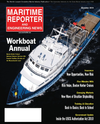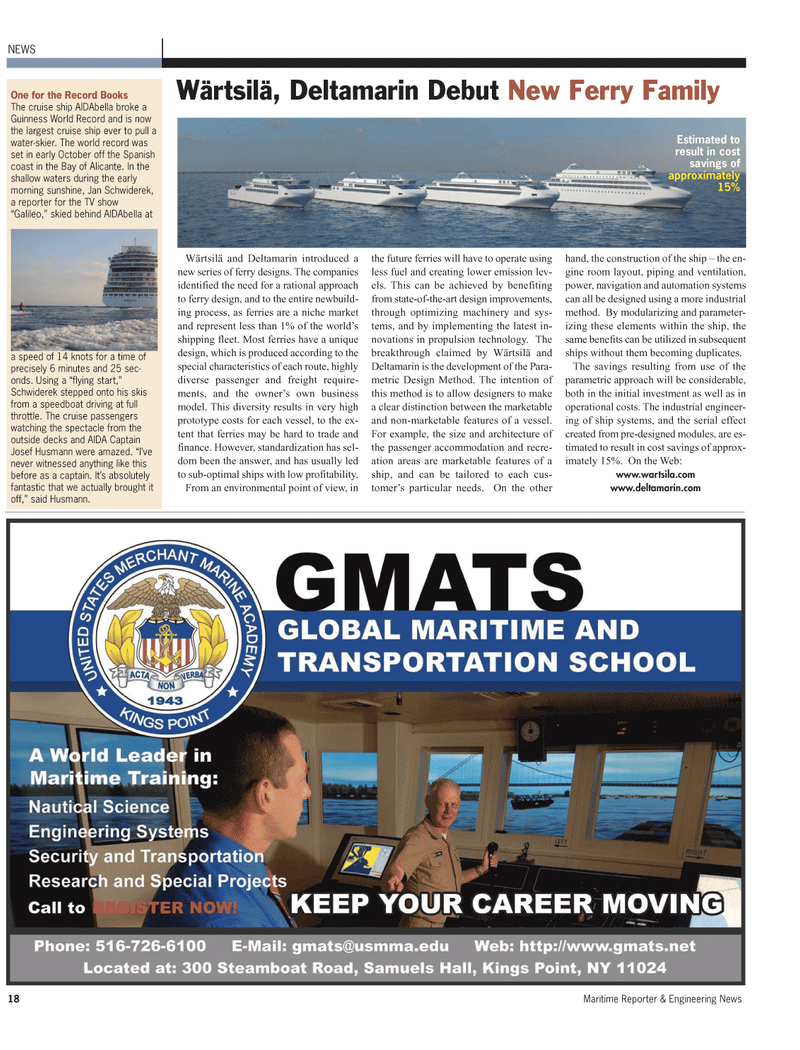
Page 18: of Maritime Reporter Magazine (November 2010)
Workboat Annual
Read this page in Pdf, Flash or Html5 edition of November 2010 Maritime Reporter Magazine
18 Maritime Reporter & Engineering News
NEWS
One for the Record Books
The cruise ship AIDAbella broke a
Guinness World Record and is now the largest cruise ship ever to pull a water-skier. The world record was set in early October off the Spanish coast in the Bay of Alicante. In the shallow waters during the early morning sunshine, Jan Schwiderek, a reporter for the TV show “Galileo,” skied behind AIDAbella at a speed of 14 knots for a time of precisely 6 minutes and 25 sec- onds. Using a “flying start,”
Schwiderek stepped onto his skis from a speedboat driving at full throttle. The cruise passengers watching the spectacle from the outside decks and AIDA Captain
Josef Husmann were amazed. “I’ve never witnessed anything like this before as a captain. It’s absolutely fantastic that we actually brought it off,” said Husmann.
Wärtsilä and Deltamarin introduced a new series of ferry designs. The companies identified the need for a rational approach to ferry design, and to the entire newbuild- ing process, as ferries are a niche market and represent less than 1% of the world’s shipping fleet. Most ferries have a unique design, which is produced according to the special characteristics of each route, highly diverse passenger and freight require- ments, and the owner’s own business model. This diversity results in very high prototype costs for each vessel, to the ex- tent that ferries may be hard to trade and finance. However, standardization has sel- dom been the answer, and has usually led to sub-optimal ships with low profitability.
From an environmental point of view, in the future ferries will have to operate using less fuel and creating lower emission lev- els. This can be achieved by benefiting from state-of-the-art design improvements, through optimizing machinery and sys- tems, and by implementing the latest in- novations in propulsion technology. The breakthrough claimed by Wärtsilä and
Deltamarin is the development of the Para- metric Design Method. The intention of this method is to allow designers to make a clear distinction between the marketable and non-marketable features of a vessel.
For example, the size and architecture of the passenger accommodation and recre- ation areas are marketable features of a ship, and can be tailored to each cus- tomer’s particular needs. On the other hand, the construction of the ship – the en- gine room layout, piping and ventilation, power, navigation and automation systems can all be designed using a more industrial method. By modularizing and parameter- izing these elements within the ship, the same benefits can be utilized in subsequent ships without them becoming duplicates.
The savings resulting from use of the parametric approach will be considerable, both in the initial investment as well as in operational costs. The industrial engineer- ing of ship systems, and the serial effect created from pre-designed modules, are es- timated to result in cost savings of approx- imately 15%. On the Web: www.wartsila.com www.deltamarin.com
Wärtsilä, Deltamarin Debut New Ferry Family
Estimated to result in cost savings of approximately 15%

 17
17

 19
19
